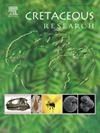中国辽西建昌九佛堂地层下白垩统(万古统)新发现的一种甘肃鸟(鸟纲,Euornithes
IF 1.9
3区 地球科学
Q1 GEOLOGY
引用次数: 0
摘要
对白垩纪鸟类中最接近现生鸟类的研究主要集中在导致现代鸟类的进化模式上。然而,人们很可能低估了并非冠类直系祖先的鸟类分支的形态和生态多样性。根据中国辽宁西部早白垩世(万年前)热河生物群的近乎完整的骨骼材料,我们建立了一个新的鸟类类群--Shuilingornis angelai gen.该新类群与近现代的羚牛类相似,但体型较小,并保留了非羚牛类中普遍存在的多形性特征。骨组织学分析表明,Shuilingornis gen.系统发生学分析有力地支持了将水岭龙新属归入甘肃龙科。除了有争议的霍兰达(Hollanda)之外,甘肃虫在四个古气候条件相似的始新世盆地均有发现。甘肃龙在白垩纪中期的成功表明,对半水生生态环境的探索是鸟臀目辐射之前的一贯模式。本文章由计算机程序翻译,如有差异,请以英文原文为准。
A new gansuid bird (Avialae, Euornithes) from the Lower Cretaceous (Aptian) Jiufotang Formation of Jianchang, western Liaoning, China
The study of the Cretaceous birds closest to the living euornithine species has mainly focused on the evolutionary patterns leading to the modern group. Yet, the morphological and ecological diversity of the euornithine branches not directly ancestral to the crown-group is probably underestimated. A new euornithine bird, Shuilingornis angelai gen. et sp. nov., is erected based on a nearly complete skeletal material from the Early Cretaceous (Aptian) Jehol Biota in western Liaoning, China. The new taxon is similar to the penecontemporary gansuids, yet it differs in the smaller body size and in the retention of plesiomorphic features widespread among non-gansuid euornithines. The osteohistological analysis indicates that Shuilingornis gen. nov. represents an early adult stage at the time of death. The phylogenetic analysis robustly supports the referral of Shuilingornis gen. nov. to Gansuidae. Except for the controversial Hollanda, the gansuids have been uncovered from four Aptian basins deposited under similar paleoclimatic conditions. Gansuid success in the middle part of the Cretaceous demonstrates that the exploration of semi-aquatic ecologies was a consistent euornithine pattern which preceded the later ornithurine radiation.
求助全文
通过发布文献求助,成功后即可免费获取论文全文。
去求助
来源期刊

Cretaceous Research
地学-地质学
CiteScore
4.10
自引率
19.00%
发文量
235
审稿时长
12 weeks
期刊介绍:
Cretaceous Research provides a forum for the rapid publication of research on all aspects of the Cretaceous Period, including its boundaries with the Jurassic and Palaeogene. Authoritative papers reporting detailed investigations of Cretaceous stratigraphy and palaeontology, studies of regional geology, and reviews of recently published books are complemented by short communications of significant new findings.
Papers submitted to Cretaceous Research should place the research in a broad context, with emphasis placed towards our better understanding of the Cretaceous, that are therefore of interest to the diverse, international readership of the journal. Full length papers that focus solely on a local theme or area will not be accepted for publication; authors of short communications are encouraged to discuss how their findings are of relevance to the Cretaceous on a broad scale.
Research Areas include:
• Regional geology
• Stratigraphy and palaeontology
• Palaeobiology
• Palaeobiogeography
• Palaeoceanography
• Palaeoclimatology
• Evolutionary Palaeoecology
• Geochronology
• Global events.
 求助内容:
求助内容: 应助结果提醒方式:
应助结果提醒方式:


